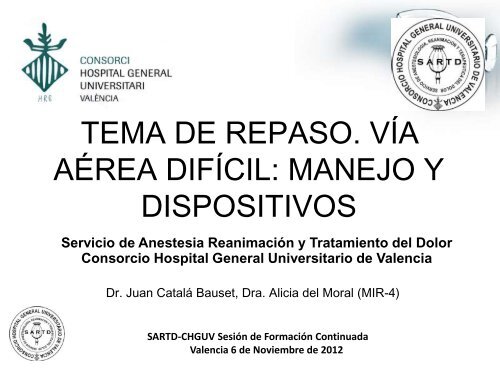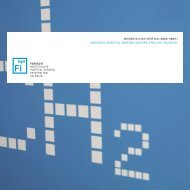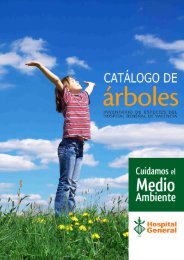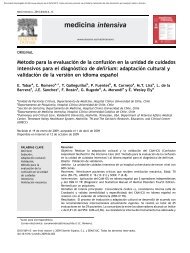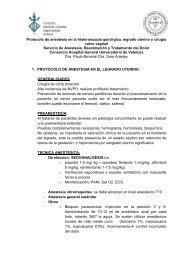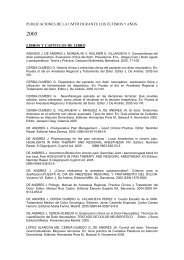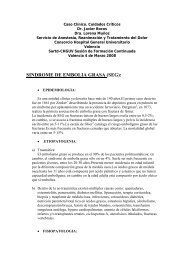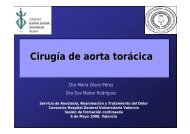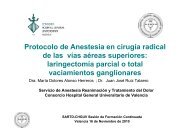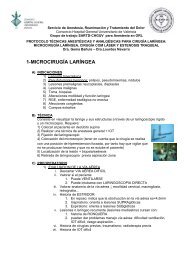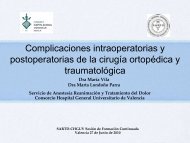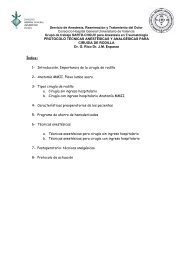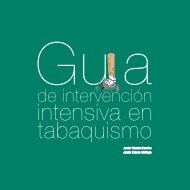CATALA-Protocolo CONTROL DE LA VIA AEREA-Sesión SARTD ...
CATALA-Protocolo CONTROL DE LA VIA AEREA-Sesión SARTD ...
CATALA-Protocolo CONTROL DE LA VIA AEREA-Sesión SARTD ...
Create successful ePaper yourself
Turn your PDF publications into a flip-book with our unique Google optimized e-Paper software.
TEMA <strong>DE</strong> REPASO. VÍA<br />
AÉREA DIFÍCIL: MANEJO Y<br />
DISPOSITIVOS<br />
Servicio de Anestesia Reanimación y Tratamiento del Dolor<br />
Consorcio Hospital General Universitario de Valencia<br />
Dr. Juan Catalá Bauset, Dra. Alicia del Moral (MIR-4)<br />
<strong>SARTD</strong>-CHGUV <strong>Sesión</strong> de Formación Continuada<br />
Valencia 6 de Noviembre de 2012
<strong>SARTD</strong>-CHGUV <strong>Sesión</strong> de Formación Continuada<br />
Valencia 6 de Noviembre de 2012
<strong>SARTD</strong>-CHGUV <strong>Sesión</strong> de Formación Continuada<br />
Valencia 6 de Noviembre de 2012
OBJETIVOS <strong>DE</strong>L TEMA<br />
1. Importancia del tema.<br />
2. Cómo definir una VA DIFÍCIL. Epidemiología.<br />
3. Importancia de la predicción.<br />
4.¿Cómo actuar ante una VA difícil?.<br />
1. Algoritmos de manejo.<br />
2. Dispositivos para el control de la vía aérea.<br />
<strong>SARTD</strong>-CHGUV <strong>Sesión</strong> de Formación Continuada<br />
Valencia 6 de Noviembre de 2012
ASA CLOSED C<strong>LA</strong>IMS<br />
STUDIES<br />
Problemas respiratorios.<br />
• Lesión única grave<br />
34%<br />
– Muerte y daño cerebral<br />
85%<br />
• Tres mecanismos de lesión:<br />
– Ventilación inadecuada<br />
– Intubación esofágica<br />
– Intubación difícil<br />
Caplan R et al. Anesthesiology 1990;72:828-833<br />
Domino KB, june 98. ASA closed claims.<br />
Peterson, G. Anesthesiology 2005; 103:33-9.<br />
<strong>SARTD</strong>-CHGUV <strong>Sesión</strong> de Formación Continuada<br />
Valencia 6 de Noviembre de 2012
<strong>SARTD</strong>-CHGUV <strong>Sesión</strong> de Formación Continuada<br />
Valencia 6 de Noviembre de 2012
<strong>SARTD</strong>-CHGUV <strong>Sesión</strong> de Formación Continuada<br />
Valencia 6 de Noviembre de 2012
Definición (ASA task force Airway Management)<br />
“Situación clínica en la que un anestesiólogo (con<br />
experiencia) tiene dificultades para ventilación<br />
facial, IT o ambas”.<br />
•O dificultad en:<br />
1.laringoscopia directa (grados de C-Lehane)<br />
2.ubicación TET: +2 intentos, o + 10 min<br />
3.por contaminación VA (vómito, etc)<br />
<strong>SARTD</strong>-CHGUV <strong>Sesión</strong> de Formación Continuada<br />
Valencia 6 de Noviembre de 2012
Definición (ASA task force Airway Management)<br />
• Dificultad para ventilación con mascarilla facial<br />
• Imposibilidad mantener saturación > 90%<br />
• Imposibilidad de revertir o prevenir signos de ventilación<br />
inadecuada:<br />
– Cianosis<br />
– Hipercapnia<br />
– Dilatación gástrica<br />
– Obstrucción<br />
– Sonidos respiratorios<br />
<strong>SARTD</strong>-CHGUV <strong>Sesión</strong> de Formación Continuada<br />
Valencia 6 de Noviembre de 2012
Incidencia de laringoscopia<br />
difícil<br />
<strong>SARTD</strong>-CHGUV <strong>Sesión</strong> de Formación Continuada<br />
Valencia 6 de Noviembre de 2012<br />
Incidencia LD: 1- 5%.
Incidencia de laringoscopia<br />
difícil<br />
<strong>SARTD</strong>-CHGUV <strong>Sesión</strong> de Formación Continuada<br />
Valencia 6 de Noviembre de 2012<br />
Incidencia LD: 1- 5%.<br />
C-L grado I C-L grado II C-L grado III C-L grado IV
TEST PREDICTIVO I<strong>DE</strong>AL<br />
1. No necesite equipamiento adicional extra o muy poco<br />
2. No invasivo<br />
3. Barato<br />
4. Reproducible<br />
5. Rápido (1-2´)<br />
6. Alto VPP<br />
<strong>SARTD</strong>-CHGUV <strong>Sesión</strong> de Formación Continuada<br />
Valencia 6 de Noviembre de 2012
Grados de HAN para la dificultad de<br />
ventilación con MF.<br />
Kheterpal S et al. Anesthesiology 2006; 105:885–9.<br />
Grado Definición N=22,260 %<br />
1<br />
2<br />
3<br />
4<br />
Ventilación con máscarilla facial<br />
eficaz, sin ayuda de dispositivo.<br />
Se precisa empleo de cánula<br />
nasal o faríngea, guedel, etc.<br />
Con o sin RNM<br />
Ventilación difícil (inadecuada,<br />
insuficiente o inestable con 2<br />
personas y empleo de cánula)<br />
Con o sin RNM<br />
Imposible la ventilación<br />
Con o sin RNM<br />
17,535 77,4 %<br />
4,775 21,1 %<br />
313 1,4 %<br />
37 0,16 %<br />
Incidencia VMF difícil: 0,07% - 5% (media 1-2%).<br />
Incidencia VMF difícil en paciente con ID: 30%.<br />
<strong>SARTD</strong>-CHGUV <strong>Sesión</strong> de Formación Continuada<br />
Valencia 6 de Noviembre de 2012<br />
ET CO2 5 mm Hg
Ventilación difícil con mascarilla facial.<br />
Langeron Oet al. Anesthesiology 2000; 92:1229–36.<br />
• Son predictores independientes de<br />
tener un grado 3 de VMD:<br />
– IMC > 30 (+E+S) (26) kg/m 2<br />
– Barbas<br />
– Hª ser roncador<br />
– Edad > 55 años<br />
– Desdentado<br />
– Limitada protusión mandibular<br />
Kheterpal S et al. Anesthesiology 2006; 105:885–9.<br />
> 2 predictores >VPP para VMD<br />
<strong>SARTD</strong>-CHGUV <strong>Sesión</strong> de Formación Continuada<br />
Valencia 6 de Noviembre de 2012
Componentes de la exploración física de la V.A.<br />
EXAMEN o EXPLORACIÓN de la Vía Aérea Hallazgos “sugerentes” de VAD<br />
1. Distancia interdental < 3 cms.<br />
2. Longitud de los incisivos superiores Relativamente largos<br />
3. Relación entre incisivos para la oclusión mandibular Arcada superior prominente<br />
4. Capacidad de protuir la mandíbula respecto maxilar Prot. Mmdb: S: 30% E:85% VP+9%<br />
5. Visibilidad de la úvula No visible<br />
6. Característica del paladar Ojival, o estrecho<br />
7. Compliance del espacio mandíbular Poco depresible, rígidez<br />
8. Longitud del cuello Corto<br />
9. Ancho del cuello > De lo habitual<br />
10. Movilidad cuello (extension atlanto-occipital) Extensión o flexión limitada<br />
<strong>SARTD</strong>-CHGUV <strong>Sesión</strong> de Formación Continuada<br />
11. Distancia tiro-mentoniana Valencia 6 de Noviembre de < 2012 6 cms. O 3 traveses dedos
1. Distancia interdental 2. Longitud de los incisivos superiores<br />
3. Relación entre incisivos para la oclusión mandibular<br />
• .<br />
.<br />
•Puede imposibilitar laringoscopia<br />
•Glotis muy anterior<br />
•Posible LMAc, Unique, PLMA,<br />
Supreme, Fastrach, C-Trach y otros<br />
SPG<br />
•FBF<br />
• < 3cm<br />
• Si < 2,5 cms: No emplear<br />
Fastrach, Ctrach.<br />
• Laringoscopia casi imposible<br />
• Si < 2 cm: dificultad con la<br />
ProSeal , Supreme y LMA.<br />
• Si < 1,8 cm: imposible LMA<br />
sobremordida<br />
<strong>SARTD</strong>-CHGUV <strong>Sesión</strong> de Formación Continuada<br />
Valencia 6 de Noviembre de 2012<br />
Resalte excesivo
5. Visión úvula – (Test Mallampati/Samsoon&Young): S 60%, E<br />
70%, VP+ 13%<br />
• I. Pilares de las fauces<br />
• Paladar blando y Úvula<br />
<strong>SARTD</strong>-CHGUV <strong>Sesión</strong> de Formación Continuada<br />
Valencia 6 de Noviembre de 2012<br />
• IV. Paladar duro
Grado 1<br />
Test de mordida del<br />
labio superior<br />
Zahid H K, Arash K, and Elham Eni. A Comparison of the Upper Lip Bite Test<br />
(a Simple New Technique) with Modified Mallampati Classification in<br />
Predicting Difficulty in Endotracheal Intubation: A Prospective Blinded Study .<br />
Anesth Analg 2003; 96: 595-9<br />
Grado 2<br />
<strong>SARTD</strong>-CHGUV <strong>Sesión</strong> de Formación Continuada<br />
Valencia 6 de Noviembre de 2012<br />
Grado 3
Componentes de la exploración física de la V.A.<br />
EXAMEN o EXPLORACIÓN de la Vía Aérea Hallazgos “sugerentes” de VAD<br />
1. Distancia interdental < 3 cms.<br />
2. Longitud de los incisivos superiores Relativamente largos<br />
3. Relación entre incisivos para la oclusión mandibular Arcada superior prominente<br />
4. Capacidad de protuir la mandíbula respecto maxilar Prot. Mmdb: S: 30% E:85% VP+9%<br />
5. Visibilidad de la úvula No visible<br />
6. Característica del paladar Ojival, o estrecho<br />
7. Compliance del espacio mandíbular Poco depresible, rígidez<br />
8. Longitud del cuello Corto<br />
9. Ancho del cuello > De lo habitual<br />
10. Movilidad cuello (extension atlanto-occipital) Extensión o flexión limitada<br />
<strong>SARTD</strong>-CHGUV <strong>Sesión</strong> de Formación Continuada<br />
11. Distancia tiro-mentoniana Valencia 6 de Noviembre de < 2012 6 cms. O 3 traveses dedos<br />
21
Ojival<br />
Estrecho y profundo<br />
Poca depresibilidad lingual<br />
Rigidez o poca movilidad de<br />
la lengua.<br />
<strong>SARTD</strong>-CHGUV <strong>Sesión</strong> de Formación Continuada<br />
Valencia 6 de Noviembre de 2012
Componentes de la exploración física de la V.A.<br />
EXAMEN o EXPLORACIÓN de la Vía Aérea Hallazgos “sugerentes” de VAD<br />
1. Distancia interdental < 3 cms.<br />
2. Longitud de los incisivos superiores Relativamente largos<br />
3. Relación entre incisivos para la oclusión mandibular Arcada superior prominente<br />
4. Capacidad de protuir la mandíbula respecto maxilar Prot. Mmdb: S: 30% E:85% VP+9%<br />
5. Visibilidad de la úvula No visible<br />
6. Característica del paladar Ojival, o estrecho<br />
7. Compliance del espacio mandíbular Poco depresible, rígidez<br />
8. Longitud del cuello Corto<br />
9. Ancho del cuello > De lo habitual<br />
10. Movilidad cuello (extension atlanto-occipital)<br />
Extensión o flexión limitada<br />
<strong>SARTD</strong>-CHGUV <strong>Sesión</strong> de Formación Continuada<br />
11. Distancia tiro-mentoniana Valencia 6 de Noviembre de < 2012 6 cms. O 3 traveses dedos<br />
23
Cuello largo o<br />
anormalmente largo<br />
Cuello corto y ancho “bull-<br />
neck”<br />
<strong>SARTD</strong>-CHGUV <strong>Sesión</strong> de Formación Continuada<br />
Valencia 6 de Noviembre de 2012
Componentes de la exploración física de la V.A.<br />
EXAMEN o EXPLORACIÓN de la Vía Aérea Hallazgos “sugerentes” de VAD<br />
1. Distancia interdental < 3 cms.<br />
2. Longitud de los incisivos superiores Relativamente largos<br />
3. Relación entre incisivos para la oclusión mandibular Arcada superior prominente<br />
4. Capacidad de protuir la mandíbula respecto maxilar Prot. Mmdb: S: 30% E:85% VP+9%<br />
5. Visibilidad de la úvula No visible<br />
6. Característica del paladar Ojival, o estrecho<br />
7. Compliance del espacio mandíbular Poco depresible, rígidez<br />
8. Longitud del cuello Corto<br />
9. Ancho del cuello > De lo habitual<br />
10. Movilidad cuello (extension atlanto-occipital)<br />
Extensión o flexión limitada<br />
<strong>SARTD</strong>-CHGUV <strong>Sesión</strong> de Formación Continuada<br />
11. Distancia tiro-mentoniana Valencia 6 de Noviembre de < 2012 6 cms. O 3 traveses dedos<br />
25
Capacidad movilidad articulación atlanto-occipital<br />
•Incapacidad de flexión y tocar barbilla-mentón<br />
•…o limitada movilidad de la articulación<br />
Distancia tiroides-mentón<br />
< 6 cms. o 3 traveses dedos<br />
Sensibilidad Especificidad VP +<br />
60% 65% 15%<br />
<strong>SARTD</strong>-CHGUV <strong>Sesión</strong> de Formación Continuada<br />
Valencia 6 de Noviembre de 2012<br />
F
Dificultad para acceso quirúrgico<br />
Diámetro del cuello<br />
Probabilidad de una Intubación<br />
problemática es alrededor de<br />
40 cm 5%<br />
60 cm 35%.<br />
<strong>SARTD</strong>-CHGUV <strong>Sesión</strong> de Formación Continuada<br />
Valencia 6 de Noviembre de 2012
Capacidad predictiva de los test<br />
“<strong>LA</strong> DIFICULTAD <strong>DE</strong> <strong>LA</strong>RINGOSCOPIA ES UN PROBLEMA<br />
MULTIFACTORIAL NO PUE<strong>DE</strong> USARSE SÓLO UN TEST<br />
PREDICTIVO”<br />
COMBINAR VARIOS TEST<br />
TEST MULTIVARIANTES<br />
<strong>SARTD</strong>-CHGUV <strong>Sesión</strong> de Formación Continuada<br />
Valencia 6 de Noviembre de 2012
<strong>SARTD</strong>-CHGUV <strong>Sesión</strong> de Formación Continuada<br />
Valencia 6 de Noviembre de 2012<br />
• Estudio prospectivo.<br />
• 2 grupos LD n=994 y<br />
VL=843.<br />
• C-L grado III y IV.<br />
• Índice multivariable<br />
predictivo de El-<br />
Ganzouri.
<strong>SARTD</strong>-CHGUV <strong>Sesión</strong> de Formación Continuada<br />
Valencia 6 de Noviembre de 2012<br />
Curva ROC
Recomendaciones finales<br />
Una historia sobre la VA debería realizarse<br />
cuando sea posible ANTES de empezar los cuidados<br />
anestésicos y manejo de la vía aérea en TODOS los<br />
pacientes.<br />
<strong>SARTD</strong>-CHGUV <strong>Sesión</strong> de Formación Continuada<br />
Valencia 6 de Noviembre de 2012
Primera referencia intubación<br />
despierto.<br />
Macewend W. Introduction of tracheal tubes by the mouth<br />
instead of performing tracheostomy or laryngotomy.<br />
British Medical Journal 1880; 2: 122-4.<br />
<strong>SARTD</strong>-CHGUV <strong>Sesión</strong> de Formación Continuada<br />
Valencia 6 de Noviembre de 2012
EVOLUCIÓN en la Vía Aérea…<br />
LD y cánula de Hewitt<br />
1ª Intubación<br />
1878<br />
Palas McIntosh/Miller<br />
cánula de Guedel<br />
1900s<br />
1933<br />
Mascarilla Laríngea<br />
1ª Fibroscopia Flexible<br />
Tubos de PVC 1950s<br />
1940s<br />
Algoritmo de la ASA<br />
1967<br />
1983<br />
<strong>SARTD</strong>-CHGUV <strong>Sesión</strong> de Formación Continuada<br />
Valencia 6 de Noviembre de 2012<br />
Videolaringoscopios 2000…<br />
1993
EVOLUCIÓN en la Vía Aérea…<br />
<strong>SARTD</strong>-CHGUV <strong>Sesión</strong> de Formación Continuada<br />
Valencia 6 de Noviembre de 2012<br />
C-MAC
ALGORITMO<br />
<strong>DE</strong><br />
<strong>CONTROL</strong><br />
<strong>DE</strong> <strong>LA</strong> VÍA<br />
AÉREA.<br />
Task Force on Management of the Difficult<br />
Airway. Anesthesiololgy 1993; 78: 597–602.<br />
<strong>SARTD</strong>-CHGUV <strong>Sesión</strong> de Formación Continuada<br />
Valencia 6 de Noviembre de 2012
VÍA AÉREA DIFÍCIL.<br />
RECONOCIDA NO RECONOCIDA<br />
A.R<br />
Optimizar preparación<br />
SI<br />
INT despierto<br />
Buena oxigenación<br />
NO<br />
TRAQUEO/CRICO<br />
A.R<br />
Optimizar preparación<br />
Inducir AG e intento INT<br />
Pedir ayuda<br />
VENTI<strong>LA</strong>CIÓN MF<br />
Alternativas INT<br />
INT tras múltiples intentos<br />
Despertar.<br />
MF.<br />
traqueotomía.<br />
NO INTUBATE NO VENTI<strong>LA</strong>TE<br />
CONFIRMAR <strong>LA</strong> VENTI<strong>LA</strong>CIÓN CON ETCO2 , SAT O2 , …<br />
<strong>SARTD</strong>-CHGUV <strong>Sesión</strong> de Formación Continuada<br />
Valencia 6 de Noviembre de 2012<br />
(considerar LMA/Combitubo)<br />
UN intento INT<br />
laringoscópica<br />
VJTT<br />
TRAQUEO/CRICO<br />
Despertar.<br />
Alternativas INT
198Os<br />
199OS<br />
2005 +<br />
INTUBACIÓN vs EXTRAGLÓTICOS.<br />
M<br />
F<br />
MASCARIL<strong>LA</strong><br />
FACIAL<br />
CM L<br />
CM L<br />
MLPs<br />
ET<br />
<strong>SARTD</strong>-CHGUV <strong>Sesión</strong> de Formación Continuada<br />
Valencia 6 de Noviembre de 2012<br />
ET<br />
ET<br />
Bryan E. Bledsoe DO, JEMS, Vol 34 No. 3,<br />
2009 Mar
<strong>SARTD</strong>-CHGUV <strong>Sesión</strong> de Formación Continuada<br />
Valencia 6 de Noviembre de 2012
DISPOSITIVOS<br />
EXTRAGLÓTICO<br />
S ESTANDAR<br />
AMBU AURASTRAIGHT<br />
AMBU AURA40<br />
AMBU AURAFLEX<br />
AMBU AURAONCE<br />
COPRAP<strong>LA</strong><br />
COPRAPLUS<br />
KING LT<br />
KING LT-D<br />
LMA-C<br />
LMA-F<br />
LMA-U<br />
SHERIDAN LM<br />
SLIPA<br />
SOFT SEAL<br />
VITAL SEAL<br />
C<strong>LA</strong>SIFICACIÓN CLÍNICA<br />
DISPOSITIVOS<br />
CON ACCESO<br />
GÁSTRICO<br />
I-GEL<br />
KING LTS<br />
KING LTS-D<br />
LMA PROSEAL<br />
LMA SUPREME<br />
AIR-Q<br />
<strong>SARTD</strong>-CHGUV <strong>Sesión</strong> de Formación Continuada<br />
Valencia 6 de Noviembre de 2012<br />
DISPOSITIVOS<br />
EXTRAGLÓTICOS<br />
INTUBACIÓN<br />
AIR-Q DISPOSABLE<br />
AIR-Q REUSABLE<br />
LMA C-TRACH<br />
LMA FASTRACH<br />
Ambu AURA-I<br />
OTROS<br />
CHOUAIRWAY<br />
EASYTUBE<br />
COMBITUBE
Cirugía rutinaria<br />
Cirugía en prono<br />
Emergencias<br />
Cuidados críticos<br />
Vía aérea difícil<br />
Usos<br />
clínicos<br />
Avanzados.<br />
Cirugía<br />
laparoscópica<br />
Obesidad<br />
Cirugía de larga duración<br />
<strong>SARTD</strong>-CHGUV <strong>Sesión</strong> de Formación Continuada<br />
Valencia 6 de Noviembre de 2012<br />
Pediatría<br />
Niño sindrómico
VÍA AÉREA DIFÍCIL.<br />
RECONOCIDA NO RECONOCIDA<br />
A.R<br />
Optimizar preparación<br />
SI<br />
INT despierto<br />
LMA intubat<br />
Buena oxigenación<br />
NO<br />
TRAQUEO/CRICO<br />
A.R<br />
Optimizar preparación<br />
Inducir AG e intento INT<br />
Pedir ayuda<br />
VENTI<strong>LA</strong>CIÓN MF<br />
Alternativas INT<br />
INT tras múltiples intentos<br />
Despertar.<br />
MF.<br />
LMA<br />
LMA<br />
intubat<br />
traqueotomía.<br />
<strong>SARTD</strong>-CHGUV <strong>Sesión</strong> de Formación Continuada<br />
Valencia ventilat 6 de Noviembre de 2012<br />
NO INTUBATE NO VENTI<strong>LA</strong>TE<br />
(considerar LMA LMA/Combitubo)<br />
UN intento ventilat INT<br />
laringoscópica<br />
VJTT<br />
TRAQUEO/CRICO<br />
CONFIRMAR <strong>LA</strong> VENTI<strong>LA</strong>CIÓN CON ETCO 2 , SAT O 2 , …<br />
Despertar.<br />
Alternativas INT<br />
LMA<br />
intubat
<strong>SARTD</strong>-CHGUV <strong>Sesión</strong> de Formación Continuada<br />
Valencia 6 de Noviembre de 2012
La laringoscopia “óptima”<br />
• Evitar pseudodificultades.<br />
• Mejor posición: “sniffing”.<br />
• Maniobra de B.U.R.P.<br />
<strong>SARTD</strong>-CHGUV <strong>Sesión</strong> de Formación Continuada<br />
Valencia 6 de Noviembre de 2012 44
Anatomia faríngea: paciente dormido<br />
EL<br />
EO<br />
EF<br />
<strong>SARTD</strong>-CHGUV <strong>Sesión</strong> de Formación Continuada EF<br />
Valencia 6 de Noviembre de 2012<br />
Boidin MP: Airway patency in the unconscious patient. Br J Anaesth 1985; 57: 306-10<br />
Nandi PR, Charlesworth CH, Taylor SJ, Nunn JF, Dore CJ: Effect of general anaesthesia on the pharynx. Br J Anaesth 1991; 66: 157-62
a l i n e a r e j e s<br />
10 cm<br />
<strong>SARTD</strong>-CHGUV <strong>Sesión</strong> de Formación Continuada<br />
Valencia 6 de Noviembre de 2012 46
Posición de “sniffing”.<br />
www.fidiva.com<br />
Adnet F. Anesthesiology 2001; 94:83–6<br />
<strong>SARTD</strong>-CHGUV <strong>Sesión</strong> de Formación Continuada<br />
Valencia 6 de Noviembre de 2012
<strong>SARTD</strong>-CHGUV <strong>Sesión</strong> de Formación Continuada<br />
Valencia 6 de Noviembre de 2012
TODO dispuesto<br />
<strong>SARTD</strong>-CHGUV <strong>Sesión</strong> de Formación Continuada<br />
Valencia 6 de Noviembre de 2012
MANIOBRA <strong>DE</strong> B.U.R.P<br />
RIGHT<br />
<strong>SARTD</strong>-CHGUV <strong>Sesión</strong> de Formación Continuada<br />
Valencia 6 de Noviembre de 2012<br />
BACK<br />
UP
Guía metálica<br />
Conexión estándar de 15 mm<br />
<strong>SARTD</strong>-CHGUV <strong>Sesión</strong> de Formación Continuada<br />
Valencia 6 de Noviembre de 2012<br />
51
<strong>LA</strong>RINGOSCOPIA vs<br />
VI<strong>DE</strong>O<strong>LA</strong>RINGOSCOPIA.<br />
<strong>SARTD</strong>-CHGUV <strong>Sesión</strong> de Formación Continuada<br />
Valencia 6 de Noviembre de 2012
Evolución de los dispositivos ópticos: Palas de<br />
laringoscopio nuevas y antiguas<br />
Laringoscopios y estiletes rígidos indirectos<br />
www.fidiva.com<br />
Laringoscopio rígido con<br />
visión óptica asistida.<br />
1. Laringoscopio Siker<br />
2. Laringoscopio<br />
espejado de<br />
McMorrow-Mirakhur.<br />
3. Prisma de Huffman<br />
4. Laringoscopio<br />
Viewmax de Rüsch.<br />
5. Airtraq.<br />
Laringoscopios rígidos de<br />
fibra óptica.<br />
1. Bullard.<br />
2. UpsherScope.<br />
3. Wuscope.<br />
4. Guía de Agustine.<br />
Estiletes rígidos y semirígidos de fibra óptica.<br />
1. Sistema de estilete con visión óptica (estilete<br />
Shikani)<br />
• Fibroscopio de intubación retromolar<br />
Bonfils (Brambrinck)<br />
• StyletScope.<br />
Dispositivos videoasistidos rígidos y<br />
semirígidos.<br />
• Tubo endotraqueal visualizado (VETT).<br />
• Estilete semirígido videoasistido<br />
- Estilete de intubación videoptica Weis<br />
- Nanoscopio Gravenstein.<br />
• Laringoscopios videoasistidos<br />
- Laringoscopio angulado de videointubación.<br />
- Videolaringoscopio (CMAC Karl-Storz)<br />
- GlideScope<br />
- AirWay Scope (AWS).<br />
- McGrath,<br />
<strong>SARTD</strong>-CHGUV <strong>Sesión</strong> de Formación Continuada<br />
Valencia 6 de Noviembre de 2012
<strong>SARTD</strong>-CHGUV <strong>Sesión</strong> de Formación Continuada<br />
Valencia 6 de Noviembre de 2012
<strong>SARTD</strong>-CHGUV <strong>Sesión</strong> de Formación Continuada<br />
Valencia 6 de Noviembre de 2012
0- 87,4 N (15.3 N) 0- 45,2 N (2,1 N)<br />
<strong>SARTD</strong>-CHGUV <strong>Sesión</strong> de Formación Continuada<br />
Valencia 6 de Noviembre de 2012<br />
56
<strong>SARTD</strong>-CHGUV <strong>Sesión</strong> de Formación Continuada<br />
Valencia 6 de Noviembre de 2012<br />
57
<strong>SARTD</strong>-CHGUV <strong>Sesión</strong> de Formación Continuada<br />
Valencia 6 de Noviembre de 2012<br />
58
• Mejoría de visión VL (mínimo I grado) = 41,5%<br />
• (igual 56%, peor 2,7%).<br />
<strong>SARTD</strong>-CHGUV <strong>Sesión</strong> de Formación Continuada<br />
Valencia 6 de Noviembre de 2012<br />
59
<strong>LA</strong>RINGOSCOPIA vs<br />
VI<strong>DE</strong>O<strong>LA</strong>RINGOSCOPIA.<br />
C-L grado<br />
C-L grado<br />
III I<br />
IIb I<br />
IIa<br />
<strong>SARTD</strong>-CHGUV <strong>Sesión</strong> de Formación Continuada<br />
Valencia 6 de Noviembre de 2012
NUEVOS<br />
VI<strong>DE</strong>O<strong>LA</strong>RINGOSCOPIOS...<br />
<strong>SARTD</strong>-CHGUV <strong>Sesión</strong> de Formación Continuada<br />
Valencia 6 de Noviembre de 2012
www.fidiva.com<br />
Choo, Canadian Journal Anesthesia, 2007<br />
Una máxima tracción implica<br />
un gran riesgo para el trauma<br />
faringeo.<br />
<strong>SARTD</strong>-CHGUV <strong>Sesión</strong> de Formación Continuada<br />
Valencia 6 de Noviembre de 2012
COMPONENTES <strong>DE</strong>L<br />
FOB<br />
CORDÓN LUMINOSO<br />
3<br />
2<br />
Cámara<br />
CORDÓN O TALLO <strong>DE</strong><br />
INSERCIÓN<br />
Canal de trabajo<br />
Haz de transmisión<br />
imágenes<br />
Haz de transmisión<br />
luminosa<br />
<strong>SARTD</strong>-CHGUV <strong>Sesión</strong> de Formación Continuada<br />
Valencia 6 de Noviembre de 2012<br />
1<br />
CUERPO:<br />
Palanca de control de la<br />
punta<br />
Ocular<br />
Anillo de enfoque<br />
Conducto de trabajo
CRICOTIROIDOTOMÍA<br />
Portex cricótomo<br />
<strong>SARTD</strong>-CHGUV <strong>Sesión</strong> de Formación Continuada<br />
Valencia 6 de Noviembre de 2012<br />
Pedia-Trake®<br />
Cricotirótomo
CRICOTIROIDOTOMÍA<br />
INDICACIONES:<br />
-PACIENTE NO INTUBABLE-NO<br />
VENTI<strong>LA</strong>BLE<br />
-PACIENTES CON TRAUMA FACIAL<br />
VENTAJAS:<br />
-NO PRECISA HIPEREXTENSIÓN <strong>DE</strong>L<br />
CUELLO<br />
-TÉCNICA RÁPIDA Y SENCIL<strong>LA</strong><br />
INCONVENIENTES:<br />
-COMPLICACIONES: SANGRADO,<br />
ESTENOSIS…<br />
-NO INDICADA EN NIÑOS < 6a<br />
Después de 5 intentos 96% en menos de 45 segundos.<br />
Wong et Al, Anesthesiology 2003<br />
<strong>SARTD</strong>-CHGUV <strong>Sesión</strong> de Formación Continuada<br />
Valencia 6 de Noviembre de 2012
Material específico organizado.<br />
Farmacología y varios.<br />
Tubos ET, Pinzas Magill, AMBU<br />
SET QUIRÚRGICO: Quicktrach,<br />
Set de Coniotomia, MANU-JET.<br />
TRANS<strong>LA</strong>RÍNGEAS.<br />
McCoy,mango corto, #1,#2,3,4,5,<br />
Bougie, FROVA, Airtraq,<br />
transiluminación…<br />
EXTRAGLÓTICOS-VENTI<strong>LA</strong>CIÓN:<br />
LMA, Fastrach. Combitube, tubo LT,<br />
Material auxiliar fibroscopia<br />
Carro intubación difícil.<br />
<strong>SARTD</strong>-CHGUV <strong>Sesión</strong> de Formación Continuada<br />
Valencia 6 de Noviembre de 2012<br />
CAJÓN 1.<br />
Técnicas percutáneas.<br />
CAJÓN 2.<br />
Técnicas<br />
translaríngeas.<br />
CAJÓN 3.<br />
Alternativas ventilación.<br />
CAJÓN 4.<br />
Técnicas fibroscópicas.
Material básico intubación.<br />
Unidad portátil para el manejo de la VAD. Madrid V,<br />
Charco P. Rev Esp Anestesiol Reanim 2001; 48: 438-9.<br />
<strong>SARTD</strong>-CHGUV <strong>Sesión</strong> de Formación Continuada<br />
Valencia 6 de Noviembre de 2012
Material básico intubación.<br />
<strong>SARTD</strong>-CHGUV <strong>Sesión</strong> de Formación Continuada<br />
Valencia 6 de Noviembre de 2012
ALGORITMO BÁSICO<br />
<strong>SARTD</strong>-CHGUV <strong>Sesión</strong> de Formación Continuada<br />
Valencia 6 de Noviembre de 2012
RECOMENDACIONES.<br />
1. Prioridad absoluta a la seguridad del<br />
paciente y, por lo tanto, a la oxigenación.<br />
2. Mayor importancia a la correcta<br />
preoxigenación.<br />
3. Despertar al paciente ante una laringoscopia<br />
C-L grado IV.<br />
4. Limitar el número de intentos de intubación a<br />
DOS.<br />
5. No continuar con los intentos de intubación<br />
ante cualquier signo de pérdida de la<br />
oxigenación.<br />
<strong>SARTD</strong>-CHGUV <strong>Sesión</strong> de Formación Continuada<br />
Valencia 6 de Noviembre de 2012
RECOMENDACIONES.<br />
6. Antes de cada nuevo intento: oxigenar y<br />
reevaluar la situación.<br />
7. Los dispositivos para ventilación SALVAN a<br />
más pacientes que los de intubación.<br />
8. Cuando el paciente pueda ventilarse la<br />
intubación pasa a ser electiva.<br />
9. Adquirir conocimientos y experiencia en las<br />
alternativas a la ventilación e intubación:<br />
simuladores o casos no difíciles.<br />
<strong>SARTD</strong>-CHGUV <strong>Sesión</strong> de Formación Continuada<br />
Valencia 6 de Noviembre de 2012
GRACIAS<br />
<strong>SARTD</strong>-CHGUV <strong>Sesión</strong> de Formación Continuada<br />
Valencia 6 de Noviembre de 2012<br />
72


